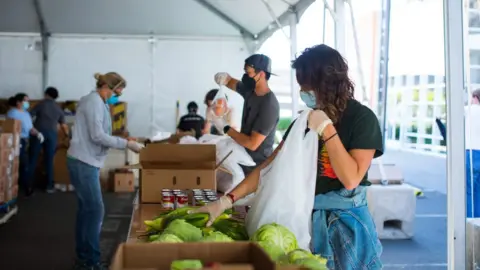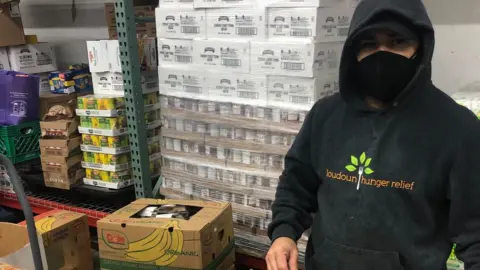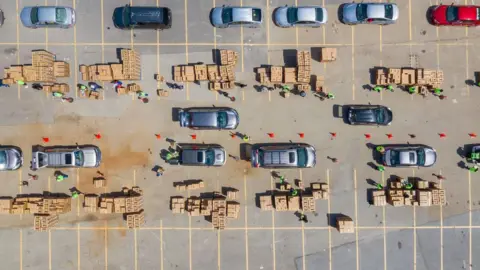Hunger spikes, demand rises for US food banks
 Reuters
ReutersFood banks across the country are straining to meet rising demand during the pandemic, even in some of the country's wealthier regions.
Karla Candelario, 30, never thought she and her husband would have to rely on a food bank to feed their family.
Before the pandemic, the couple, who live in Loudoun, Virginia, were getting by with their combined salaries, Karla caring for the elderly and her husband working in construction.
But last June, Candelario lost her job. "That's when everything changed," she says.
The sudden loss of income and an unexpected and necessary $3,000 (£2,250) dental procedure that Candelario had to undergo put the family, which includes four children - an 11-year old, a nine-year-old, and four-year-old twins - under serious financial strain.
 Courtesy San Franscisco Marin Food Bank
Courtesy San Franscisco Marin Food BankThey have recently been so "high in debt", Candelario says, that they have depended on Loudoun Hunger Relief, a food pantry in Leesburg, Virginia, to put food on the table.
The Candelarios are not alone in their unforeseen struggles.
More Americans are going hungry than at any point during the Covid-19 pandemic, according to data by the Census Bureau.
One in eight Americans reported they sometimes or often did not have enough food in November, according to a recent census survey.
Nearly 26 million adults - 12% of all adults - reported in that their household had food shortages in the past week, according to Household Pulse Survey data collected in November.
Overall, food insecurity has doubled since last year, reaching the highest level since 1998, when data about US household ability to get enough food was first collected.
Although hunger is not new in America, the pandemic has had a major impact. Food insecurity has become a widespread national issue sparing not even some of the wealthier regions.
 Courtesy Loudoun Hunger Relief
Courtesy Loudoun Hunger ReliefSince early November, not far from Trump National Golf Club in Virginia, in an area that used to have some of the lowest hunger rates in the country, Loudoun Hunger Relief fed between 750 and 1,100 households a week - a 225% average increase from its pre-pandemic weekly average.
"We saw folks who had just never needed to access this type of resource before," says executive director Jennifer Montgomery.
"It was obvious that they were very much one or two pay checks away from being in serious trouble."
The San Francisco-Marin Food Bank, which operates in some of the richest US counties - San Francisco and Marin - has been serving about 60,000 households, double its pre-Covid average, says its executive director, Paul Ash.
Before coronavirus, the elderly and the underemployed accounted for the majority of the food bank's clients, but there has been a recent influx of service workers who have been disproportionately hit by the pandemic, Ash says.
Economic conditions are the main causes behind hunger, says Diane Whitmore Schanzenbach, an economist and the director of Northwestern University's Institute for Policy Research.
Food insecurity rates spiked at the end of March, when pandemic lockdowns made the US economy stumble.
The situation slightly improved as businesses slowly reopened. Another help was the $2.2tn federal relief package, passed by Congress in late March, which included unemployment benefits, incentives for businesses to keep workers on the payroll, and support for food programmes.
But the economic conditions "have softened again," says Prof Schanzenbach, and benefits for millions of Americans are due to expire.
Unless Congress, which has been deadlocked on the issue since the summer, soon agrees on a new coronavirus stimulus package, some 12 million workers will see aid benefits, including certain jobless benefits, end on 31 December.
Families with children have been the most affected, for a variety of reasons.
As schools closed, many parents had to hire babysitters or decide whether one parent would stop working to stay home and care for the children - choices often resulting in less income, says Montgomery, from Loudoun Hunger Relief.
Children staying home also means higher utility bills and extra meals to prepare.
Millions of children get free or reduced-price meals at school, says Prof Schanzenbach, "and losing access to that really hurts" for families already on the brink.
Throughout the pandemic, food banks and pantries have provided millions of Americans with much needed food.
"They give us a lot," says Candelario. "Chicken, beef, vegetables, beans, eggs, cheese, bread, cereal, coffee, cream… I always hope to get chicken so that I can make arroz con pollo, my kids' favourite."
Loudoun Hunger Relief gives the family enough to make three healthy meals a day for as many as 14 days, she says.
She goes grocery shopping only when the food pantry cannot provide other miscellaneous items, like paper towels, shampoo and dish soap.
The food pantry packs everything in regular grocery bags to protect families' privacy and to remove as many barriers as possible to the service.
"We are cognisant that it's not easy to show up here and to ask for help," says Montgomery.
 Courtesy SF-Marin Food Bank
Courtesy SF-Marin Food BankPrior to the pandemic, families could drop by the food pantry at any time and choose between a variety of products, alongside the basics. Due to Covid-19, it now strictly operates on a curbside pickup model and requires advance appointments, made online or by phone.
The online appointment system was created because the influx of calls "was so high that we just couldn't get to the phone fast enough to take them all", says Montgomery.
The only requirement to receive food is to be a resident of the county and, so far, the pantry has managed to never turn a client away - but this might not be sustainable for much longer.
They are "very concerned" about what the new demand is going to be and whether they can continue to meet it, says its executive director.
With benefits about to expire and Christmas holidays around the corner, "which are always financially stressful", says Ash, it is very likely that more people will need help.
This makes it crucial for Congress to quickly pass another Covid-19 aid package, says Prof Schanzenbach, as food banks cannot keep operating at this rate, which is "impressive but certainly not sustainable".
"There's real urgency to get more relief at the hands of families," she says.
Candelario is about to start a part-time job at a gas station and hopes that this will help her family's finances get back on track.
But in the meantime, the family has no choice but to keep going to the food pantry, she says.
"We have to go in order to feed the kids. We do it for them."
